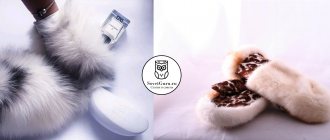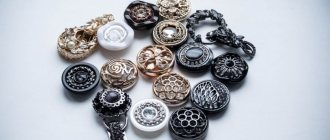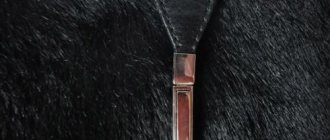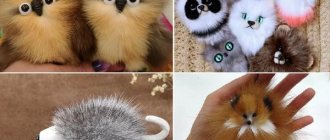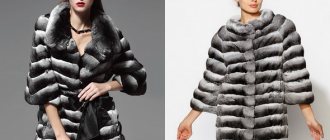Clothes made from natural fur have always been valued. Currently, a fur coat is not only warm and comfortable clothing for the winter, but also a kind of indicator of a lady’s status. Any woman in a good expensive fur coat looks much more representative than in a banal down jacket or coat. Clothing made from natural fur makes a woman more sophisticated, seductive and gives her charm.
Almost every representative of the fair sex in our country has a fur coat, and often more than one. But often these things lie for years, and no one wears them. This happens for many reasons: the model is outdated, the fur is worn out and shiny in places, the style of the product is inconvenient, etc. Old fur coats collect dust in closets. At the same time, the hand does not raise them to throw them away, and no one wants to wear them.
In this case, you should think about repairing and restoring your fur coat. This is much more profitable than buying a new one. At the same time, a craftsman in an atelier can transform an old item in such a way that it will look as if the price tag has just been removed from it.
Defects on fur products
When is fur coat restoration necessary? The following signs indicate this:
- the edges of the sleeves are frayed;
- the fur has rubbed off on the pockets and at the bottom of the product;
- the fur coat is torn (along the seam or along the skin);
- the lining is worn out;
- bald patches appeared in any area;
- The fittings are damaged: buttons, hooks, loops are torn off, along with small areas of fur.
In addition, restoration of a fur coat may include changing the color, style, length, adjusting to the figure or a complete alteration.
Often such work involves the use of additional materials: similar fur for inserts, or completely different fur for a new collar, sleeves, or trim. All this affects the cost of rework. The final price for repairing a fur product can only be found out when the technician examines the item and determines the degree of wear, and also listens to the client’s wishes.
Is it possible to fix defects yourself and is it worth doing?
If restoring a fur coat made of mink or other fur seems too expensive to you, then you can try to refresh the item yourself. But I would like to immediately note that this is not an easy matter, and not everyone will be able to achieve results without spoiling the product.
Not every seamstress will undertake the repair of a fur product: such work requires experience. It is necessary to understand the principles of working with fur and the base (skin), know dyeing methods, and the technology of sewing fur coats, which has a lot of nuances and professional secrets.
Therefore, you can only sew up a fur coat that is torn at the seam yourself: carefully, trying not to damage the base (and with old products, the skin is dry and tears easily). In all other cases, you should contact a furrier.
Our quality guarantees
We guarantee our work. If during the season the loop or hook we installed comes off again, we will replace it free of charge. If the seam comes apart, our craftsmen will repair the gap out of turn. We would like to note that such requests have not yet been made.
We guarantee high quality clothing repair and our other services. Quality guarantees at Mobile Tailor are:
- more than 10 years of experience
- modern sewing equipment made in Germany, Switzerland and Japan
- highly qualified craftsmen who already have a regular clientele
- our clients, including well-known brands, for example, the Denim Symphony chain of stores, Lee-Wrangler, Modis, Familia
- our responsibility to landlords.
You can find guarantees for the safety of products and guarantees for work performed in this section.
How to restore fur coats from different furs
When buying a brand new fur coat in a store, women often do not understand that they are choosing not only fur, but also all the subsequent problems. Different fur deteriorates over time in different ways: some things by their nature are prone to certain changes.
For example, fur coats made from seals, beavers and otters are prone to becoming greasy: the fur becomes dull due to a greasy, sticky coating that must be removed in a timely manner.
Light-colored items made from astrakhan fur, arctic fox and snow-white mink turn yellow over time. This defect can be eliminated by degreasing and cleaning the pile, and then applying talc mixed with hydrogen peroxide to it. But it is better to contact fur cleaning specialists.
Karakul and goat are prone to wiping. This is especially noticeable on the sides, pockets and cuffs. Astrakhan fur coats can be repaired using fur inserts (the seams will be invisible) or leather patches. The easiest way to update a goat item is with contrasting leather patches.
Nutria and rabbit fur coats are rarely restored. The service life of such things is short (3-5 years, no more), since even with an excellent appearance, the base quickly wears out and breaks. And when you try to re-stitch it, it literally crawls apart under the needle.
Restoring a mink coat is a labor-intensive process. The fur is long, very beautiful and quite durable. In order not to visually reduce the cost of the product, for repairs you need to select a similar material in color. However, it is also possible to have leather inserts on problem areas (looks good on sheared mink), or trim with more expensive fur, which will look like a decoration, and not like a patch.
Masters work with any material. They can repair fur coats made from fox, nutria, sheepskin, and chinchilla. In cases where there is a possibility of damage to the product due to severe wear of the skin (most often it is nutria, rabbit or marmot), the furrier warns the customer about the risk, and she makes a decision.
Learning to furrier
The next problem that indicates the need to restore a mink coat is loose seams. Most often this occurs in the chest area, on the back or in the armholes of the sleeves. First we deal with the lining: if it is stitched, it must be carefully torn off so that we have access to the area that requires repair. Do not use a sewing machine for restoration; it is advisable to sew up the tear using a furrier’s stitch (photo) by hand; to do this, practice on an inconspicuous area. The main thing is that when sewing, make sure that the fur does not get into the seam, and also adjust the thread tension so that the seam does not turn out to be too tight. At the end of this complex operation, sew up the lining, and you can be proud of yourself - after all, you did everything with your own hands!
Worn fur emphasizes the old age of your fur coat. You will have to put a patch in place of the abrasion. For these purposes, you can use a piece cut from a collar, pocket, belt or hood. You can also choose a new skin of a suitable color and pile. Using a sharp blade, carefully cut off, trying not to affect the pile, the patch of the desired size. At the end of this jewelry operation, it is necessary to tap the junction of the main product and the patch with a wooden hammer through paper, which will align the old and new fur and level the restoration site (photo).
A very unpleasant and difficult problem to overcome at home is the splitting of a fur coat, when fur fibers on the collar, sleeves, and hood spread out to the very core. This is, one might say, a natural defect that can occur even with a new mink model. You can deal with this problem at home if you have a household steam generator, but it’s better to take the fur coat to a repair shop.
Let's become fashion designers
When purchasing an expensive mink model, you expect that you will wear it for a long time, but capricious and changeable fashion interferes with your regular life, or you are simply tired of your old, but still quite like new, model, and you decide to make drastic changes, for example, shorten it. First you need to decide on the length, to do this, put on a fur coat, button it up and tie the belt, carefully straighten it and pin the hem with tailor's pins.
Measure the required length along the entire hem of the fur coat, do not forget to leave 4 cm for the seam allowance, then, using a sharp blade, carefully cutting with forward movements, cut off the excess. Tuck the fur and sew it over the edge with a seam, aligning the right and left edges
All that remains is to sew on the lining and straighten the fur that got into the seam (pictured before and after).
And in the end, some tips on how to care for a mink coat so that you don’t have to restore it for as long as possible.
- To ensure longevity, try not to wear fur in wet weather. If it does get wet, dry it away from heating devices, preferably in a natural draft. In summer, regularly ventilate the product in the shade.
- Protect fur from moths, as natural fur infected with moth larvae cannot be restored. Currently, there are many ways to protect yourself from harmful insects: from banal orange peel and geranium to industrial sprays and solutions. Well, it’s better to leave grandma’s proven old method - mothballs - in the past, since you will get rid of moths, but you will no longer be able to remove the fetid odor from your favorite fur coat.
- Store your fur coat in a special case in a spacious closet so that the fur does not come into contact with the walls of the closet or other clothes and does not get wrinkled.
https://youtube.com/watch?v=xT5NaN1GqQQ
Using these simple tips will preserve the appearance for a long time and will save you from having to restore your fur coat yourself or turn to professionals for help.
Atelier or fur restoration at home: what to choose
Services for restoration and alteration of fur products are often offered to be performed directly at the master’s home. Can they be trusted? Of course, if there are recommendations from friends or acquaintances. But you should always remember that you are giving an expensive item into the hands of a stranger. Of course, not all furriers working at home are scammers, but some of them are self-taught, who can easily ruin a fur coat with their inept actions.
Below is an example of an unsuccessful restoration of a fur coat (pictured), which was entrusted to such would-be masters.
The studio may also not be very successful in refreshing your fur coat. But the customer will have a receipt, an advance payment check, and sometimes the receipt indicates exactly what will be done with the item. All this evidence can be taken to court if the product was damaged.
Sizing and changing model
When they say “restoration of a mink coat,” they often mean changing the style of the product. Mink is a durable material and will last at least 10 seasons, although not as warm as muton or arctic fox. But at the same time, mink fur looks very expensive and respectable.
But good preservation leads to the fact that the fur coat becomes hopelessly outdated - it can no longer be worn. The master can turn a flared model into a fitted or straight one, or adjust the item to her figure if the client has lost weight.
In cases where the fur coat has become small, you can add new fur inserts.
Signs that repairs are needed
Clothing made from natural fur has many advantages. It has an attractive appearance, provides amazing comfort and reliably protects from the cold.
A high-quality mink coat can be worn for at least 10 seasons. However, sometimes an expensive product deteriorates in just a few months. Following certain clothing care recommendations will help you avoid this.
The reasons why there is a need for product repair include the following:
- Loss of lint. As a result, creases and bald spots appear on the surface of the clothing. The causes of such problems are washing the product, constant exposure to ultraviolet radiation, and the use of an iron. Also, bald spots are caused by the use of aggressive chemicals for cleaning, the use of a hair dryer to dry the product, and damage to the fur by moths.
- The appearance of holes and tears. Such problems are caused by various jewelry - hairpins, pins or brooches. Also, a fur coat may tear due to a mismatch in the size of the product.
- The appearance of deformations and abrasions. This is due to carrying bags on the shoulders. Also, deformed areas appear as a result of traveling in a car or full public transport.
In order not to be disappointed when using an expensive product, you should be very careful about the purchasing process. Only a high-quality fur coat can last for many years.
Length adjustment
Mouton fur coats are very warm and practical. They are not cold in the most severe frost, and not hot in damp, slushy weather. Previously, many people refused to buy mouton fur coats because of their unattractive appearance. But modern technologies have made it possible to make exquisite and very feminine models from such skins in a wide variety of cuts and colors (the fur is dyed, since the natural color is not the most attractive).
Such things last a long time; the service life will depend on the quality of the dressing and sewing of the skins. But over time, everything deteriorates and the fur is wiped off. Sometimes only the bottom of the product loses its attractiveness, especially if it is long.
Restoration of a mouton fur coat - or any other fur - is as follows: the length is shortened, removing all damaged areas and processing the edge. You can go another way: increase the length with inserts that match the color and structure - this can be done on a long model with a damaged bottom, or increase the length of a short fur coat.
Methods for eliminating surface damage
Unfortunately, it often happens that a beautiful mink coat after just a couple of months of intensive wear can lose its original charm. Fur pile has the following properties:
- Roll down;
- to press down;
- acquire a yellowish or dark tint.
In such situations, you should not despair, since all of the listed shortcomings are not at all difficult to eliminate with your own hands at home and qualitatively restore the fur coat. What should be done to ensure that the result pleases you with its effectiveness?
- It is recommended to comb dusty and slightly wrinkled areas of a fur product intensively, but carefully, using a special brush.
- For heavily matted fur, use a wide-tooth comb. It must be made of natural wood.
- If some fur areas are too dirty, to clean them you need to use a brush pre-moistened in a mixture of 1 liter of warm water and 1 tablespoon of washing powder.
- Another option for an effective cleaning agent is a mixture of natural starch and high-quality purified gasoline. It will help you quickly and easily update the appearance of the product.
- To clean fur of dark shades, it is recommended to use warm and clean sand - and it must be perfectly dried.
Traces of perfume can only be removed with ammonia.
How to update a mink coat by completely changing its cut
If all of the above methods for restoring a mink coat are powerless, and the damage is truly serious, the best solution would be to change the cut of this product. It is very difficult to restore a product, so it is unlikely that you can cope with this yourself at home - professional experience and special equipment are needed here. The only thing you can do with your own hands is to turn a well-worn long mink coat into a short, fashionable vest.
https://youtube.com/watch?v=-BMEnbtGqSE
Depending on the degree of wear of the fur product and the nature of its damage, you can always choose the most optimal restoration method. After all, updating your favorite fur coat is, in any case, the most accessible opportunity to become the owner of a completely “new” piece of clothing.
